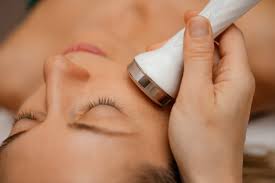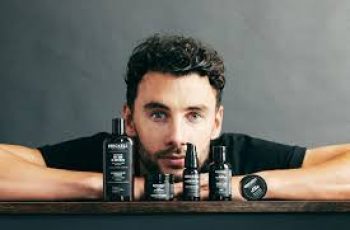
I Tried Glacial Rx—The Latest Cryocosmetic Treatment—and My Skin Has Never Looked Better
The best part of waking up is when I can finally ice my face, as it helps reduce puffiness and gives me that extra glow I desperately need in the morning. Cold therapy is one of my favorite parts of my skincare routine, despite being the cheapest and fastest-acting. So you might imagine I jumped at the chance to try Glacial Rx, a brand new cryocosmetic treatment (aka cold facial) that promises to brighten skin and reduce age spots and hyperpigmentation in the least painful way possible.
After researching treatments before my first visit to the Schaeffer Clinic, I asked myself: How can a device that sounds similar to my cheap ice roller have such a big effect on hyperpigmentation and redness? When I arrived at the clinic in Manhattan, I was greeted by Lucia Miranda LE CME, who would be performing my treatment. I explained to her how I struggle with hyperpigmentation and how I constantly work to prevent breakouts (often linked to heat and sun). She assured me that not only would I love the treatment, but that this new technology could be the key to finally solving my problems. Learn everything you need to know about Glacial Rx below.
What is Glacial Rx?
“Glacial Rx is an FDA-approved CryoAesthetic treatment that uses precision cooling technology to brighten the skin, reduce redness, and speed up exfoliation,” explains Dr. Dendy Engelman, a board-certified dermatologist at the Schaeffer Clinic in New York City. “It is also approved for the removal of benign lesions, such as solar lentigo and macular seborrheic keratosis.” Engelman says the treatment uses a new technology called cryoconditioning, which “uses cold to inhibit melanin production, reducing age spots and hyperpigmentation.”
Dr. Bruce Katz, director of Juva Skin and Laser Center in New York City, is conducting clinical trials of Glacial Rx, and his clinic is the first in the U.S. to offer the treatment. Dr. Katz explains in more detail how cryoconditioning works: “When people develop hyperpigmentation, there is a mechanism involving tyrosinase, an enzyme that stimulates pigment cells to produce pigment, and cryoconditioning prevents this from happening.” Katz adds that the treatment was developed at Harvard by the same scientist who invented CoolSculpting.
The Glacial Rx treatment consists of three treatment modalities, although it is a two-phase treatment with the third being a targeted spot treatment.
Benefits of Glacial Rx
Reduces redness and inflammation
Helps and reduces hyperpigmentation and dark spots
Reduces dull skin
Tightens skin
“This treatment reduces inflammation and gives the skin a radiant glow,” says Dr. Engelman. “Glacial Rx offers two unique types of skin clearing, dermatitis and spot treatments, and interrupts the inflammatory cycle to reduce inflammation, resulting in calm, clear skin and the elimination of benign lesions and dark spots.”
Dr. Katz says other benefits of Glacial Rx are still being studied. “In addition to treating pigment and inflammation, we’ve found it to be effective for rosacea as well,” he says. “We also treat psoriasis and are studying how it can treat acne.” The benefits of Glacial Rx aren’t limited to the face, either: “We use it on other parts of the body to treat pigmentation and inflammation,” adds Glacial Rx’s Dr. Katz.
Although the benefits of the treatment can last up to a year, according to Dr. Katz, further research is needed. He also says you’ll notice results after one or two treatments. However, Dr. Engman says that patients need about three treatments on average, depending on their goals. For example, I’ve had two treatments so far (one month apart) and was recommended three.
Preparing for Glacial Rx
Since I stopped taking prescription Retin-A a while ago, nothing in my skincare routine needed to be stopped prior to treatment. However, for those who do, it’s recommended to stop using any retinoids 2-3 days beforehand, and not use fillers or neurotoxins for at least two weeks prior to a Glacial Rx treatment.
What to Expect During a Glacial Rx Treatment
Miranda performed my first and second treatments, and she only used two of the three treatments on my face. The Glacial Rx treatment uses a handheld device that can best be described as a cold plate, which is the part your provider glides over your skin.
Miranda started the treatment with the “glow” technique, which involves cooling the skin, followed by microdermabrasion. This method treats the skin with continuous cooling, with the option of additional topical medications, to illuminate the skin by combating inflammation and accelerating exfoliation. Microdermabrasion is usually a little harsh on my skin, but the continuous cooling made it feel like almost nothing happened.
She then moved on to the second method, the “glide” technique. As Miranda told me, this method “delivers precise cooling to the skin, almost instantly resulting in calmer, more radiant skin. It can be used as a stand-alone treatment or in conjunction with lasers and other treatments to relieve pain, inflammation, and heat damage.”
The last technique I didn’t have to use was focused freezing therapy (also known as precision cryotherapy). The technique is a targeted treatment that involves freezing benign lesions.
The entire treatment took about 45 minutes; it was so soothing and relaxing. As promised, the treatment left the skin radiant, and with a few follow-up products, I looked like a glazed donut.
Before + After
During the winter months, my melasma/hyperpigmentation calms down, though it still persists in very bright light. However, with Glacial Rx, I noticed a huge improvement in my melasma and skin redness after just one treatment, with no downtime. Other treatments I’ve received for hyperpigmentation caused damage to my skin for a few days.
Possible Side Effects
Glacial Rx is safe for all skin types, painless, and has minimal to no side effects. Dr. Engleman says that Gloss and Glide treatments cause no downtime. However, spot treatments may cause several days of downtime.
Cost
Glacial Rx costs vary by provider, but average about $550 per session. At the Schaeffer Clinic, each of the three modalities has its own cost to provide a customized treatment. The Glide Technique is priced at $800, Gloss is priced at $1,500, and the Focused Freeze Spot Treatment is priced at $500.
Aftercare
Patients receive a branded Glacial Rx take-home package, which includes Almond Pigment Correcting Serum and Molecular Barrier Regenerating Balm. Dr. Katz also recommends that if your skin feels sensitive after treatment, continue to avoid retinoids or irritating ingredients for a week after treatment. Otherwise, you can return to your regular skin care routine. As for care, Dr. Katz says you may need one or two booster treatments per year, but there is no definitive data on this yet.
Final Verdict
Glacial Rx delivers on its promise of making skin glow, reducing redness, and reducing hyperpigmentation. I wish I had tried this treatment sooner, but nonetheless, I am thrilled with my results. After two treatments, I saw a difference and look forward to the third. I like that this treatment is 45 minutes long, so you can easily fit it in during your lunch break. Although Glacial Rx is a bit pricey, it is worth it if you want to effectively and painlessly treat hyperpigmentation, redness, or benign lesions.


